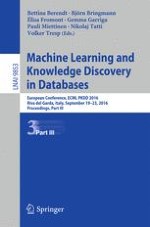The three volume set LNAI 9851, LNAI 9852, and LNAI 9853 constitutes the refereed proceedings of the European Conference on Machine Learning and Knowledge Discovery in Databases, ECML PKDD 2016, held in Riva del Garda, Italy, in September 2016. The 123 full papers and 16 short papers presented were carefully reviewed and selected from a total of 460 submissions. The papers presented focus on practical and real-world studies of machine learning, knowledge discovery, data mining; innovative prototype implementations or mature systems that use machine learning techniques and knowledge discovery processes in a real setting; recent advances at the frontier of machine learning and data mining with other disciplines. Part I and Part II of the proceedings contain the full papers of the contributions presented in the scientific track and abstracts of the scientific plenary talks. Part III contains the full papers of the contributions presented in the industrial track, short papers describing demonstration, the nectar papers, and the abstracts of the industrial plenary talks.
